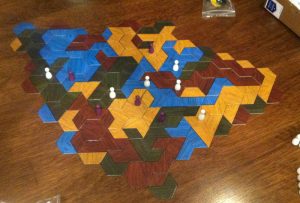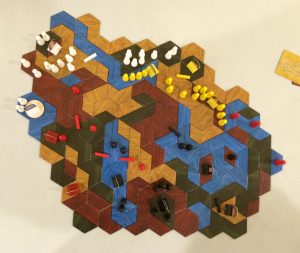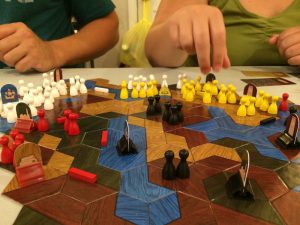Generations – Colonization, Industrialization, & War… a triple threat (7.5/10)
Generations is a 4x game(ish) that has broken up the 4x into phases. This game was sent to us by Adam Browne. Although the game is effectively 3 games, it uses the same components throughout. As such, I have decided to do a single review rather than three separate reviews.
Gameplay: 8/10
Style: 7/10
Pacing: 8/10
Thematic: 8/10
Easy to Learn: 7/10
Replayability: 7/10
Overall: 7.5/10
Game Genre: 4x Game
Highlights:
- Revolutionary three phase game – 3 games in 1!
- So much game in this one game!
- A lot of fun to play!
- 4x’s aren’t for everyone.
How to Play
First Generation: Discovery (~45 min)
Players take turns drawing hexagonal tiles and placing them. Each tile has 2 areas on them that denote water (blue), town (red), forest (green), or farmland (yellow). The pieces are laid together creating connected territories. A player earns population (pawns) when they play a tile that matches an edge of the existing map from previously played tiles. These people pawns represent the people willing to settle your land.
What if I want to accumulate people faster? Well, well, well, look who’s getting selfish! But hey, this is Discovery, not vacation bible school. If you are exploring, you probably have selfish motives. So how do you do it? By claiming it! Place one of your people on a territory. Now each subsequent turn when you add to that territory you earn 2 people. And if you happen to close off an opponents owned territory you earn 3 people.
Players take turns using 2 actions: 1) Place, 2) Place again, or 3) Claim
These can be performed in any order.
The game ends when all tiles have been placed.
The winner is the player with the highest score.
Score = Your population – Your Scouts
Second Generation: Conquest (~60 min)
The second generation takes off where the first left off, with a discovered land that badly needs some conquest. Each of you has a population, but if either of you did particularly bad (population of less than 30) then now is the time where you are given more population. Draw up to 30 population OR if you already have 30 or more population sit tight.
Each player is given a building cost card, trade routes (wooden sticks), a plastic card stand, 3 dice, and industry pieces.
Each turn players utilize 2 phases: 1) building & 2) populating.
BUILDING
To build a building you must trade people from a given region. For example, if you want to build a ship, it requires 3 townsfolk (brown locations), 2 craftsmen (green locations), 0 farmers (yellow locations), and 5 sailors (blue locations).
You may only build 1 type of a building for each industry. You may trade in people from anywhere on the map. you may place an industry anywhere on it’s type of color (useful for generation 3).
You may also build trade routes which enable you to move your population between two neighboring territories, giving you more flexibility when building industries.
POPULATING
To populate the map, you roll the dice (1 numbered and 2 colored). When rolling the colored dice, it shows you in what color territories you can add population. The color dice also has a question mark side, which is like a wildcard side, and a skull, which acts as a destruction marker. The numbered die tells you how many people to add/remove.
There is also destroying an industry and fortifying. Basically a double skull lets you destroy another player’s industry and rolling a double wildcard (?) let’s you fortify it against a double skull.
The end of the game occurs when a player completes their 4th industry.
Third Generation: War (~90 min)
The third generation takes off where the 2nd generation left it. You have a map with people and industries on it with trade routes connecting territories. To win this generation you must destroy all of your opponents’ people and industries.
Firstly, turn all of your trade routes sideways; they are now blockades. And then a funny reorganization occurs where people switch seats, a verification of the assets on the field.
Now the game begins. The turn order is broken down in 2 phases: 1) Movement & 2) Battle. You can move each of your people across 1 border between territories and only move into territories owned by you. You can also move a blockade, but blockades don’t actually block other players’ people. They appear to be for rezoning borders but it wasn’t really explained well.
Then you battle, you choose a single location to attack from. Then you choose the territories you are attacking. Each player then rolls a dice. The higher value wins. The lower value loses 1 person.
Your industries from the previous generation now act as in game bonuses if you attack from their locations. Ships grant you the ability to roll 2 dice from their location. Towers allow you to attack any territory on the map, Farms let you double the people placed during an occupation, and factories let you add a random amount to your roll (granted from factory cards).
Final Thoughts
So when I first read the rules to this game my mind was set aglow with what a revolution concept this was.The designer ultimately took what would have been a clumsy setup to the game and made it an abstract game with strategy and merit. Then he took either another phase of setup (placing people and industries) and made it a spatial Euro, and then finally he either made teardown a game or it was the game which ultimately was a war game.
I thought to myself, “What a curious mixture of games! I love it!” And now that I’ve had a chance to play it through over the last couple of months, I can honestly say that I still think it’s a great game, but the details of the implementation might have gone a little askew.
Let’s talk about what he did right: an evolutionary game that takes you from setup all the way to tear down with some light to mid-level euro in between. Lovely. I enjoyed the staging and the thought provoking fun in between. Good times. The 2nd Generation is my favorite. But the 1st generation is a close 2nd.
But, those highlights were quickly offset by the looming generation 3. I’m not a huge fan of war games, but I can be if there is enough thought to them. Unfortunately this war game in generation 3 seemed to lack much of that. The closest we came to unique unit deployment was in the way of industries that allowed you to use certain functions and the borders that let you roll an additional dice. But for all of that, most of the time it came down to a 1 die vs 1 die scenario. And due to much of the cohesiveness of the map, it was somewhat too cohesive. War Games like Axis and Allies and Risk strive off of terrain. This game lacked that as well.
But man.. the abstract intro and the euro in between were so good. So in summary, I would stick to generations 1 and 2 and perhaps write my own rules for generation 3. Perhaps allow players to turn in strength of numbers for special skills giving them enough of a cerebral workout to make the finale a provoking engagement.
In the end, I gave the game a 7.5/10 if only for the quality of the game components & the enjoyment I had from generations 1 and 2.
This game is highly recommended and can be picked up here: https://www.thegamecrafter.com/games/generations



